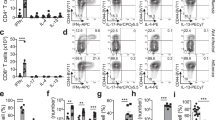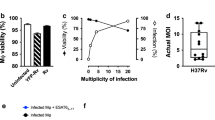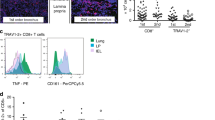Abstract
THE biological role of cells bearing the γδS T-cell antigen receptor (TCR) is as yet unclear1-3. Although there are indications that some γδ+ cells can mediate cytotoxicity4-7, their antigen-related functions have not yet been defined. In the mouse, γδ+ ceils constitute 1–3% of T cells in lymphoid organs8,9. Intestinal intraepithelial lymphocytes (lELs) and dendritic epidermal cells (DECs) also appear to carry the γδ TCR6,10-13. The strategic locations of DECs and lELs have led to the suggestion that γδ+ cells could constitute a first line of defence in the vicinity of large surfaces of contact with the environment14. We report here that an estimated 8–20% of resident pulmonary lymphocytes (RPLs) are CD3+αβ TCR−, and presumably γδ TCR+. Furthermore, mice exposed to aerosols containing a Mycobacterium tuberculosis extract have an increased number of activated CD3+αβ-TCR− pulmonary T cells which can be propagated in vitro.
This is a preview of subscription content, access via your institution
Access options
Subscribe to this journal
Receive 51 print issues and online access
$199.00 per year
only $3.90 per issue
Buy this article
- Purchase on Springer Link
- Instant access to full article PDF
Prices may be subject to local taxes which are calculated during checkout
Similar content being viewed by others

References
Saito, H. et al. Nature 309, 757–762 (1984).
Chien, Y. et al. Nature 328, 677–682 (1987).
Raulet, D. H. A. Rev. Immun. 7, 175–207 (1989).
Borst, J. et al. Nature 325, 683–688 (1987).
Brenner, M. B. et al. Nature 325, 689–694 (1987).
Goodman, T. & Lefrancois, L. Nature 325, 689–694 (1987).
Matis, L. A., Cron, R. & Bluestone, J. A. Nature 330, 262–264 (1987).
Cron, R. et al. J. Immun. 141, 1074–1082 (1988).
Pardoll, D. M. et al. Nature 326, 79–81 (1987).
Bonneville, M. et al. Nature 335, 479–481 (1988).
Stingl, G. et al. Proc. natn. Acad. Sci. U.S.A. 84, 4586–4590 (1987).
Kuziel, W. A. et al. Nature 328, 263–266 (1987).
Asarnow, D. M. et al. Cell 44, 837–847 (1988).
Janeway, C. A. Nature 333, 804–806 (1988).
Kubo, R. et al. J. Immun. (in the press).
Howe, R. C., Perazzini, T. & MacDonald, H. R. Eur. J. Immun. 19, 25–30 (1989).
Orme, J. M. J. Immun. 138, 4414–4418 (1987).
Wilson, G. S. & Miles, A. (eds) Topley and Wilson's Principles of Bacteriology Virology and Immunology 6th edn (Arnold, Frome and London, 1975).
Elliot, J. F. et al. Nature 331, 627–631 (1988).
Dobbs, L. G., Gonzalez, R. & Williams, M. C. A. Rev. Resp. Dis. 134, 141–145 (1986).
Kubo, R. T. & Roehm, N. Molec. Immun. 23, 869–878 (1986).
Author information
Authors and Affiliations
Rights and permissions
About this article
Cite this article
Augustin, A., Kubo, R. & Sim, GK. Resident pulmonary lymphocytes expressing the γ/δ T-cell receptor. Nature 340, 239–241 (1989). https://doi.org/10.1038/340239a0
Received:
Accepted:
Issue Date:
DOI: https://doi.org/10.1038/340239a0
This article is cited by
-
γδ T cells: origin and fate, subsets, diseases and immunotherapy
Signal Transduction and Targeted Therapy (2023)
-
Nutritional immunity: the impact of metals on lung immune cells and the airway microbiome during chronic respiratory disease
Respiratory Research (2021)
-
Immune Alterations in a Patient with SARS-CoV-2-Related Acute Respiratory Distress Syndrome
Journal of Clinical Immunology (2020)
-
Th17 cells are not required for maintenance of IL‐17A‐producing γδ T cells in vivo
Immunology & Cell Biology (2017)
-
Double-negative T resident memory cells of the lung react to influenza virus infection via CD11chi dendritic cells
Mucosal Immunology (2016)
Comments
By submitting a comment you agree to abide by our Terms and Community Guidelines. If you find something abusive or that does not comply with our terms or guidelines please flag it as inappropriate.


